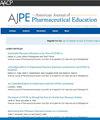Comparing Analytic and Mixed-Approach Rubrics for Academic Poster Quality
IF 3.8
4区 教育学
Q1 EDUCATION, SCIENTIFIC DISCIPLINES
引用次数: 0
Abstract
Objective
Although there has been great interest in rubrics in recent decades, there are different types (with different advantages and disadvantages). Here, we examined and compared the use of analytic rubrics (AR) and mixed-approach rubric (MAR) types to assess the quality of research posters at an academic conference.
Methods
A previous systematic review identified 12 rubrics. We compared 2 notable ARs (AR1 and AR2) with a newer MAR. Sixty randomly selected research posters were downloaded from an academic conference poster repository. Two experienced academicians independently scored all posters using the AR1, AR2, and MAR. The time to score was also noted. For inter-rater reliability of scores from each rubric, traditional intraclass correlations and modern/advanced Rasch measurement were examined and compared between AR1, AR2, and MAR.
Results
The scores for poster quality varied using all rubrics. For traditional indexes of inter-rater reliability, all rubrics had equal or similar intraclass correlations using agreement, whereas AR1 and AR2 were slightly higher using consistency. The modern Rasch measurement showed that the single-item MAR reliably separated posters into 2 distinct groups (low quality vs high quality), which is the same as the 9-item AR2 but better than the 9-item AR1. Furthermore, the MAR’s single-item rating scale functioned well, whereas AR1 had 1 misfunctioning item rating scale and AR2 had 4 misfunctioning item rating scales. Notably, the MAR was quicker to score than the AR1 or AR2.
Conclusion
This MAR measured similar or better than 2 ARs and was quicker to score. This investigation illuminated common misconceptions that ARs are more accurate and a best use of time for effective measurement.
比较分析和混合方法的学术海报质量标准。
目的:近几十年来,人们对评分标准产生了浓厚的兴趣,但评分标准也有不同类型(优缺点各异)。在此,我们研究并比较了分析评分标准(AR)和混合方法评分标准(MAR)的使用情况,以评估学术会议上研究海报的质量:我们比较了两种著名的分析评分标准(AR1、AR2)和一种较新的混合方法评分标准(MAR)。我们从学术会议海报库中随机下载了 60 份研究海报。两位经验丰富的院士使用 AR1、AR2 和 MAR 对所有海报进行独立评分。同时还记录了评分时间。对每个评分标准的评分者之间的可靠性进行了研究,并对 AR1、AR2 和 MAR 之间的传统类内相关性以及现代/高级 Rasch 测量进行了比较:所有评分标准的海报质量得分均有差异。就评分者之间的传统可靠性指标而言,所有评分标准在一致性方面的类内相关性相同或相似,而 AR1 和 AR2 在一致性方面的类内相关性略高。现代 Rasch 测量表明,单项目 MAR 能可靠地将海报分为两个不同的组别(低质量组和高质量组);与 9 个项目的 AR2 相同,但优于 9 个项目的 AR1。此外,MAR 的单项评分量表功能良好,而 AR1 有一个功能错误的项目评分量表,AR2 有四个功能错误的项目评分量表。值得注意的是,MAR 比 AR1 或 AR2 的评分速度更快:结论:MAR 的测量结果与 AR1 和 AR2 相似或更好,而且评分更快。这项调查揭示了人们普遍存在的误解,即年度报告更准确,而且能充分利用时间进行有效测量。
本文章由计算机程序翻译,如有差异,请以英文原文为准。
求助全文
约1分钟内获得全文
求助全文
来源期刊
CiteScore
4.30
自引率
15.20%
发文量
114
期刊介绍:
The Journal accepts unsolicited manuscripts that have not been published and are not under consideration for publication elsewhere. The Journal only considers material related to pharmaceutical education for publication. Authors must prepare manuscripts to conform to the Journal style (Author Instructions). All manuscripts are subject to peer review and approval by the editor prior to acceptance for publication. Reviewers are assigned by the editor with the advice of the editorial board as needed. Manuscripts are submitted and processed online (Submit a Manuscript) using Editorial Manager, an online manuscript tracking system that facilitates communication between the editorial office, editor, associate editors, reviewers, and authors.
After a manuscript is accepted, it is scheduled for publication in an upcoming issue of the Journal. All manuscripts are formatted and copyedited, and returned to the author for review and approval of the changes. Approximately 2 weeks prior to publication, the author receives an electronic proof of the article for final review and approval. Authors are not assessed page charges for publication.

 求助内容:
求助内容: 应助结果提醒方式:
应助结果提醒方式:


